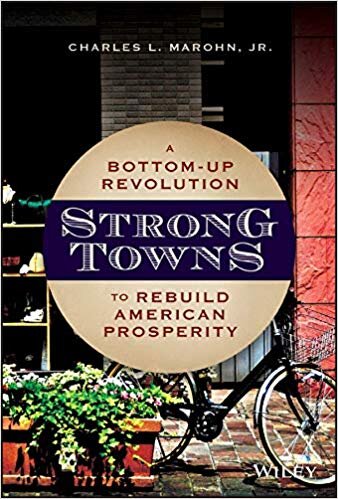 |
I don't remember when I first ran across the work of Charles Marohn, who founded Strong Towns as an urbanism advocacy organization in 2009. It was probably around 2013, when I was doing research for a college course on the phenomenon of place, and in the process fell in with new urbanism. I've spent countless hours listening to the Strong Towns podcast, reading (and occasionally contributing to) the blog, and using Strong Towns material in my classes. (The current work will be assigned reading this fall in my Politics of the City course.) In 2015, Corridor Urbanism, the local group I co-founded, hosted Marohn for a public talk in Iowa City and an appearance before county officials in Ely.
Marohn has published collections of his blog posts--I have two of these in my office--but the current book is the first that systematically presents his ideas. Needless to say its publication has been the object of much anticipation in the Strong Towns universe. What follows here is less a review than a reading diary.
The first two chapters of Strong Towns describe the factors that led to the suburban model of development which has dominated American places since World War II, and why that model is proving problematic. The causal factors were political (land values too high in mature cities for new people to achieve success, concerns about returning to a peacetime economy) and financial (plenty of available money as America emerged from the war as the only undamaged power), but also professional hubris (belief that certain experts possessed the formula for building successful places) [pp. 27-30]. This combination of factors promoted and enabled risky behavior, because governments, mostly the U.S. federal government, were taking on the risk instead of local public and private actors. As a result:
Modern development is built all at once and to a finished state, a condition that does not naturally induce the rising land values necessary to drive redevelopment and renewal. We have defeated the stifling constraint of high land values, but in exchange we sacrificed the stability that has been the hallmark of cities throughout time. [p. 30]In explaining how so many professionals got things so wrong, Marohn draws on the ideas of philosopher Nassim Taleb and physicist Neil Johnson. All three are redolent to me of the 18th century British political writer Edmund Burke, who criticized the rationalism that dominated the world of ideas in the Age of Enlightenment. Burke viewed with alarm proposals to overthrow social institutions in the name rationality; his Reflections on the Revolution in France, published in 1791, anticipated the bloodbath it would become when its rationalism ran smash into reality. His argument, even early on, was that social institutions contained collective wisdom that no individual or group of individuals could approximate. We aren't, in short, as smart as we think we are, and we should approach change with due caution. (For this wisdom he was long known as the "father of conservatism," though given what conservatism has become today he would surely demand a paternity test.)
| Burke |
The underlying assumption of the American development pattern is an abundance of resources.... We could, as Johnson suggested, act "cleverly or stupidly, and yet still end up with an embarrassment of riches." And we did.... Have a crime problem? Just hire more police.... Have a traffic congestion problem? Just build more lanes.... Are sales at the big box store stagnating? Just close it and build a new one in a better location.... No matter the problem, and no matter how bad it becomes, there is no force compelling us to evolve our habitat, to change the way we live together. [p. 13]
 |
| 16th Av SW at Williams Blvd, Nov. 2017 |
Marohn commends returning to our species' legacy of "small, isolated bets [which are] an opportunity to gain knowledge at low risk.... In fact, it's better to fail early when the stakes are low" (p. 17). But in towns across America, large or small or medium-sized (like mine), the belief remains in an easy fix in some "game-changing" form or other, along with the assumption that a federal grant can be attained to pay for it. We're running out of time to learn this lesson. This book gives Marohn and Strong Towns another crack at teaching it.
 |
| Bike lanes are examples of "small bets" that don't cost very much to implement |




No comments:
Post a Comment